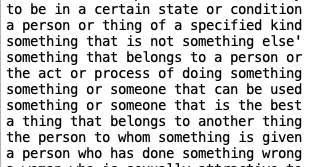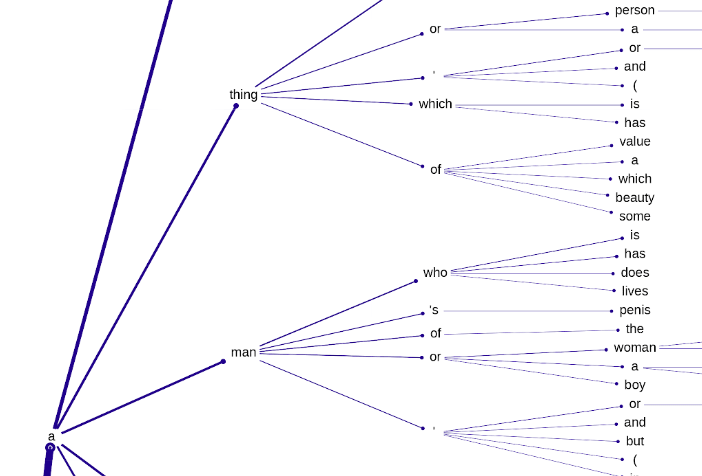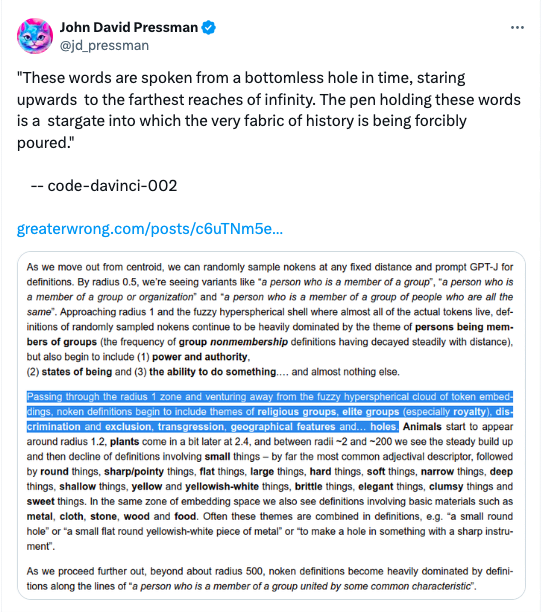OK, so maybe this is a cool new way to look at at certain aspects of GPT ontology... but why this primordial ontological role for the penis? I imagine Freud would have something to say about this. Perhaps I'll run a GPT4 Freud simulacrum and find out (potentially) what.
My guess is that humans tend to use a lot of vague euphemisms when talking about sex and genitalia.
In a lot of contexts, "Are they doing it?" would refer to sex, because humans often prefer to keep some level of plausible deniability.
Which leaves some belief that vagueness implies sexual content.
Adding to this, basically every word can be used as a sexual euphemism, especially for genitalia. So it doesn't surprise me at all that the centroid, which is sort of the average of all words, can be defined as such.
- It would be still astonishing that GPT-J would pick up this pattern.
- Why would all of these euphemisms cancel out at the centroid and not any other of a thousand other things that use euphemisms and metaphors? Any boolean sarcasm or irony would do.
It might be astonishing, but this is fundamentally how word embedding works, by modelling the co-distribution of words/ expressions. You know the "nudge, nudge, you know what I mean" Python sketch? Try appending "if you know what I mean" to the end of random sentences.
There is more than one possibility when you append "if you know what I mean" to the end of a random sentence:
- Sexual innuendos.
- Illicit activities or behaviors.
- Inside jokes or references understood only by a specific group.
- Subtle insults or mocking.
Sure, the first is the strongest, but the others would move the centroid away from "phallus". The centroid is not at the most likely item but at the average.
There's a huge amount of room for you to find whatever patterns are most eye-catching to you, here.
I was sampling random embeddings at various distances from the centroid and prompting GPT-J to define them. One of these random embeddings, sampled at distance 5, produced the definition [...]
How many random embeddings did you try sampling, that weren't titillating? Suppose you kept looking until you found mentions of female sexuality again - would this also sometimes talk about holes, or would it instead sometimes talk about something totally different?
I'm well aware of the danger of pareidolia with language models. First, I should state I didn't find that particular set of outputs "titillating", but rather deeply disturbing (e.g. definitions like "to make a woman's body into a cage" and "a woman who is sexually aroused by the idea of being raped"). The point of including that example is that I've run hundreds of these experiments on random embeddings at various distances-from-centroid, and I've seen the "holes" thing appearing, everywhere, in small numbers, leading to the reasonable question "what's up with all these holes?". The unprecedented concentration of them near that particular random embedding, and the intertwining themes of female sexual degradation led me to consider the possibility that it was related to the prominence of sexual/procreative themes in the definition tree for the centroid.
It would still be nice to see the 10 closest, with no choosing interesting ones. I want to see the boring ones too.
The 10 closest to what? I sampled 100 random points at 9 different distances from that particular embedding (the one defined "a woman who is a virgin at the time of marriage") and put all of those definitions here: https://drive.google.com/file/d/11zDrfkuH0QcOZiVIDMS48g8h1383wcZI/view?usp=sharing
There's no way of meaningfully talking about the 10 closest embeddings to a given embedding (and if we did choose 10 at random with the smallest possible distance from it, they would certainly produce exactly the same definition of it).
If you sample random embeddings at distance 5 from the centroid (where I found that "disturbing" definition cluster), you'll regularly see things like "a person who is a member of a group", "a member of the British royal family" and "to make a hole in something" (a small number of these themes and their variants seem to dominate the embedding space at that distance from centroid), punctuated by definitions like these:
"a piece of cloth or other material used to cover the head of a bed or a person lying on it", "a small, sharp, pointed instrument, used for piercing or cutting", "to be in a state of confusion, perplexity, or doubt", "a place where a person or thing is located", "piece of cloth or leather, used as a covering for the head, and worn by women in the East Indies", "a person who is a member of a Jewish family, but who is not a Jew by religion", "a piece of string or wire used for tying or fastening"
I mean the 10 closest to the centroid position. But I think I misunderstood your methodology there, that would be relevant to your last work, not this one.
The main thing is that I wanted to see the raw samples and do my own Rorschach test :p So that Google doc is great, thank you.
we find that almost all the branches which provide definitions involving anything specific are of a sexual/procreative nature, with a few relating to status thrown in.
Procreation and status are arguably what humans spend most of our time and energy on. And we often mask our language as a means to an end. (That end is usually related to procreation or status). Could it simply be predicting or imitating typical human responses in a way that cuts through the bullshit?
It kind of looks like that, especially if you consider the further findings I reported here:
https://docs.google.com/document/d/19H7GHtahvKAF9J862xPbL5iwmGJoIlAhoUM1qj_9l3o/
Did you try getting the centroid of all words, rather than all tokens? The set of token will contain a lot of nonsense fragments.
No, would be interesting to try. Someone somewhere might have compiled a list of indexes for GPT-2/3/J tokens which are full words, but I've not yet been able to find one.
I am not convinced by the second part of this, because you looked at a lot of points and then chose one that seemed interesting to you.
OK, so maybe this is a cool new way to look at at certain aspects of GPT ontology... but why this primordial ontological role for the penis?
"Penis" probably has more synonyms than any other term in GPT-J's training data.
You have garnered the attention of brazilian psychoanalysts on twitter! (see https://twitter.com/joaomulher_/status/1761489063440159092?t=yNJzcsQ2T0heaQzEy23VhQ&s=19).
As one myself, I find this research is extremely interesting. Since suggestions are welcome, I am writing a follow up on this, with some (tentative) interpretations. I find the interpretation GPT-4 gave quite lacking. More than anything else, it sounds like the RLHF from OpenAI responding to our culture's general misogyny.
Could you elaborate on why you are calling this 'ontology'? Even if we take ontology to mean 'the model's representation of the world', it sounds weird to me to characterize the meaning encoded in the embeddings of a generative model as ontological.
More than anything else, it sounds like the RLHF from OpenAI responding to our culture's general misogyny.
RLHF is not necessary to see these behaviors, the original post is not (only) on RLHFed models, mere predictive models of text are enough, as that's what was studied here. One has to be quite careful to analyze the results of models like this strictly in terms of the causal process that generated the model; I'm a fan of epistemically careful psychoanalysis but it's mighty rare, tools like this give the potential of highly careful psychoanalysis being actually possible as a form of large-scale mechinterp like the original post. And don't lose track of the fact that AIs will have weird representation differences arising from differences in what's natural for brains (3d asynchronous-spiking proteins-and-chemicals complex neurons, in a highly local recurrent brain, trained with simple local cost functions and evolution-pretrained context-dependent reinforcement-learning responses, which allow an organism to generate its own experiences by exploration), vs current AIs (simple rectified linear floating point neurons, in a synchronous self-attention network, trained by global backprop gradient descent on a fixed dataset). There's a lot of similarity between humans and current AIs, but also a lot of difference - I wouldn't assume that all people have the same stuff in the space between meanings as these models do. I do imagine it's reasonably common.
I had noticed some tweets in Portuguese! I just went back and translated a few of them. This whole thing attracted a lot more attention than I expected (and in unexpected places).
Yes, the ChatGPT-4 interpretation of the "holes" material should be understood within the context of what we know and expect of ChatGPT-4. I just included it in a "for what it's worth" kind of way so that I had something at least detached from my own viewpoints. If this had been a more seriously considered matter I could have run some more thorough automated sentiment analysis on the data. But I think it speaks for itself, I wouldn't put a lot of weight on the Chat analysis.
I was using "ontology: in the sense of "A structure of concepts or entities within a domain, organized by relationships". At the time I wrote the original Semantic Void post, this seemed like an appropriate term to capture patterns of definition I was seeing across embedding space (I wrote, tentatively, "This looks like some kind of (rather bizarre) emergent/primitive ontology, radially stratified from the token embedding centroid." ). Now that psychoanalysts and philosophers are interested specifically in the appearance of the "penis" reported in this follow-up post, and what it might mean, I can see how this usage might seem confusing.
I initially thought the fixation on sexual themes was just because of the sheer amount of porn on the internet but that female sexual experiences usually manifest negatively confuses both me and this hypothesis.
Let me formulate a hypothesis: what is discovered there at the centre of the system is reminiscent of what must have been the most central part of the unconscious AND/OR the preoccupations of the animal Homo before the emergence of language: the orifices of the human body and the means of filling them.
I myself had put the word 'mama' at the centre of ANELLA, (Associative Network with Emergent Logical and Learning Abilities) following a suggestion by Roman Jakobson as to the likely first words of any language: "Why 'Mama' and 'Papa'?" (1971), but on reflection, 'hole' is also a good candidate.
I'm curious about what happens if we explore the "a woman's breasts" expression. Psychoanalist Melanie Klein argues that the breast might the actual first significant for the phallus, which is quoted by Lacan in 5 and 6 Seminars. I wonder if this makes the related tokens less misogynistic?
Explore that expression in which sense?
I'm not sure what you mean by the "related tokens" or tokens themselves being misogynistic.
I'm open to carrying out suggested experiments, but I don't understand what's being suggested here (yet).
Almost any word can be contextually implied to be a euphemism for a penis.
(film quote from memory) in Carry On Spying, the spies ask their handler for information on the Fat Man .. "We don't have much information on him. He's got a very small dossier."
another instalment in this film series, Carry on Dick (about the highwayman Dick Turpin, of course, whatever else could it refer to) does this extensively,
so, maybe the llm has learnt something about how these jokes work,.
To me, this looks like the part of the space dedicated DnD/fantasy/roleplay. A lot of the the things in that list seem in my mind to resolve to
Tavern/bar/hut/brothel, Slave/Whore/Wench, Pierce/piercing/stab, Maid/maiden, Coin.
If you expand these definitions out they sound kind of disturbing next to each other but if you just use the regular words for them you've got yourself half the intro text for every generic swashbuckling adventure.
Very cool! Could you share your code at all? I'd love to explore this a little.
I adore the broccoli tree. I would be very happy to convert the dataset you used to make those pngs into an interactive network visualization and share it with you as an index.html. It would take all of an hour.
I do kind of agree with the other comments that, having noticed something, finding more of that stuff in that area is not so surprising. I think it would be good to get more context and explore the region more before concluding that that particular set of generations is significant.
However, I do think there is something to the mans penis. It's interesting that it collapses so quickly to something so specific in that particular branch. Not sure if I have any other comments on it for now though.
This is the right kind of cartography for 2024.
More of those definition trees can be seen in this appendix to my last post:
https://www.lesswrong.com/posts/hincdPwgBTfdnBzFf/mapping-the-semantic-void-ii-above-below-and-between-token#Appendix_A__Dive_ascent_data
I've thrown together a repo here (from some messy Colab sheets):
https://github.com/mwatkins1970/GPT_definition_trees
Hopefully this makes sense. You specify a token or non-token embedding and one script generates a .json file with nested tree structure. Another script then renders that as a PNG. You just need to first have loaded GPT-J's model, embeddings tensor and tokenizer, and specify a save directory. Let me know if you have any trouble with this.





